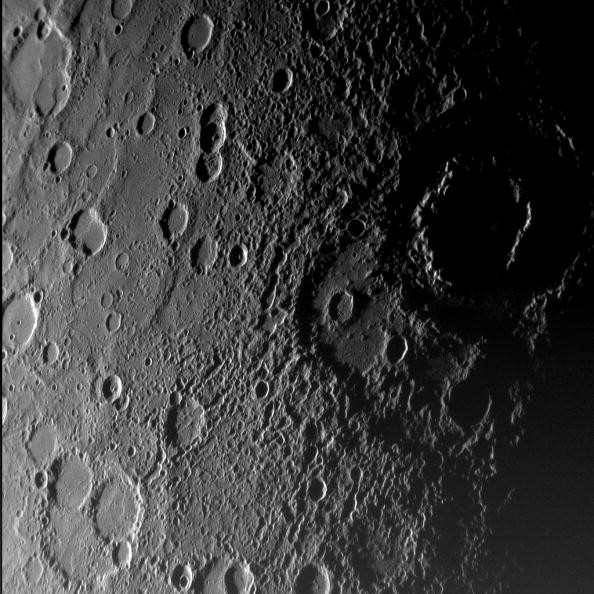Mercury Gets Shrouded In Mystery With Latest NASA Findings
| KJ Belonio | | Jun 17, 2015 05:17 PM EDT |
(Photo : Getty Images/NASA) A strange pattern on Mercury’s surface recently raised a newfound mystery for experts. Based on the photos taken by NASA’s MESSENGER spacecraft, a pattern of giant cliffs and ridges have mysteriously turned up on Mercury’s surface. However, there are no evidence to further explain the origin of the geological formations.
After interesting news about planet Mars have recently been reported, Mercury is now taking the spotlight. According to the latest NASA reports, a strange pattern on Mercury's surface raised a newfound mystery for experts.
An enigmatic planet for years, Mercury is considered as the smallest and innermost world in the solar system. Fortunately, NASA's MESSENGER spacecraft was able to give Earth a glimpse of the planet after it became the first probe to orbit Mercury. Live Science also revealed that NASA's Mariner 10 probe has conducted flybys around the planet for four decades.
Like Us on Facebook
Based on the photos taken by NASA's MESSENGER spacecraft, a pattern of giant cliffs and ridges have mysteriously turned up on Mercury's surface. And since there are no evidence to further explain the origin of the geological formations, scientists were left baffled.
The cliffs found resembled giant stair steps in the landscape. As described by Space.com, the largest cliffs are more than 600 miles long and over 1.8 miles high. Previous studies also suggest that most scientists agree that the cliffs and faults found were probably formed by the gradual cooling of Mercury's core, which also caused the planet to shrink by about 2.5 to 8.7 miles in diameter.
If the theory in the prior research was proven true, then the scarps would be evenly scattered across the surface of the planet. However, it is not. That's why scientists were confounded and the origin of the geological formations remain unexplained.
"It is a real mystery," Smithsonian Institution's National Air and Space Museum planetary scientist Thomas Watters said, as Sputnik News quoted.
The study, which was spearheaded by Watters, also revealed that scientists discovered numerous faults are concentrated in two wide bands that run north to south and are located on almost opposite sides of the planet. And after analyzing the largest scarps, researchers concluded that the direction of the bands may reflect the flow of hot rock in Mercury's mantle.
Watters also added that since the scale of flow in Mercury's mantle is not very thick, there are still other factors responsible for the formation of cliffs and ridges that they don't have a knowledge on yet. The scientists admitted that they still have a lot to learn about Mercury.
For the time being, researchers will continue to investigate and analyze images and data taken by the Messenger. They are also feeling optimistic that more information will be gathered from the BepiColombo spacecraft, which is set to launch in 2017. As reported, the exploration is a joint mission of the European Space Agency (ESA) and the Japan Aerospace Exploration Agency (JAXA).
Scientists have also emphasized that understanding Mercury is truly a significant factor in order to explain how planets may evolve elsewhere in the galaxy. Meanwhile, the recent findings are detailed in the journal Geophysical Research Letters.
TagsMercury, outer space, mystery, NASA, Science
©2015 Chinatopix All rights reserved. Do not reproduce without permission
EDITOR'S PICKS
-

Did the Trump administration just announce plans for a trade war with ‘hostile’ China and Russia?
-

US Senate passes Taiwan travel bill slammed by China
-

As Yan Sihong’s family grieves, here are other Chinese students who went missing abroad. Some have never been found
-

Beijing blasts Western critics who ‘smear China’ with the term sharp power
-

China Envoy Seeks to Defuse Tensions With U.S. as a Trade War Brews
-

Singapore's Deputy PM Provides Bitcoin Vote of Confidence Amid China's Blanket Bans
-

China warns investors over risks in overseas virtual currency trading
-

Chinese government most trustworthy: survey
-

Kashima Antlers On Course For Back-To-Back Titles
MOST POPULAR
LATEST NEWS
Zhou Yongkang: China's Former Security Chief Sentenced to Life in Prison

China's former Chief of the Ministry of Public Security, Zhou Yongkang, has been given a life sentence after he was found guilty of abusing his office, bribery and deliberately ... Full Article
TRENDING STORY

China Pork Prices Expected to Stabilize As The Supplies Recover

Elephone P9000 Smartphone is now on Sale on Amazon India

There's a Big Chance Cliffhangers Won't Still Be Resolved When Grey's Anatomy Season 13 Returns

Supreme Court Ruled on Samsung vs Apple Dispute for Patent Infringement

Microsoft Surface Pro 5 Rumors and Release Date: What is the Latest?










